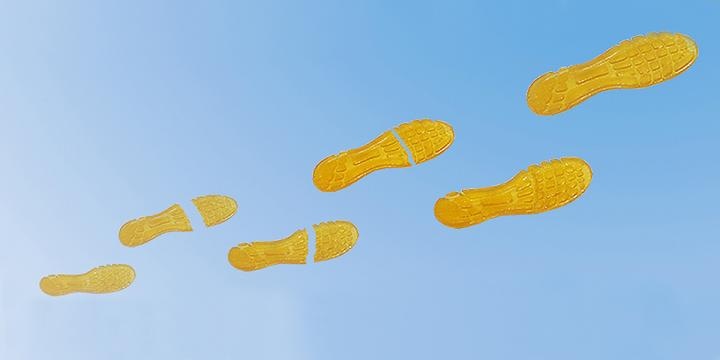Feb 6 2019
Cracked toys or broken boots are often discarded, but instead of throwing these things away, it would be better to let them fix themselves.
 This is a severed 3D-printed shoe pad repairing itself. (CREDIT: An Xin and Kunhao Yu)
This is a severed 3D-printed shoe pad repairing itself. (CREDIT: An Xin and Kunhao Yu)
Now, 3D-printed rubber materials, developed by scientists at the University of Southern California Viterbi School of Engineering, are capable of doing just that.
Working in the realm of 3D-printed materials, Assistant Professor Qiming Wang creates innovative functions for a wide range of purposes, ranging from sound control to flexible electronics. Now, in association with Ying Li, an Assistant Professor from the University of Connecticut, and with Viterbi students Kunhao Yu, An Xin, and Haixu Du, the researchers have created a novel material that can be developed rapidly and has the ability to repair itself upon becoming punctured or fractured. This unique material could revolutionize a number of industries like soft robotics, tires, shoes, and also electronics, reducing the manufacturing time while simultaneously boosting the longevity and durability of products.
A 3D printing technique based on photopolymerization is used for developing the material. In this process, light is used to solidify a liquid resin in a preferred geometry or shape. To make this resin self-healable, the researchers had to delve further into the chemistry behind the novel material.
Photopolymerization is obtained via a reaction with a specific chemical group known as thiols. When an oxidizer is added to the equation, thiols convert into another group known as disulfides. This disulfide group is capable of reforming when broken, resulting in the self-healing ability. Identifying the correct ratio between these pair of groups was integral to reveal the unique characteristics of the materials.
When we gradually increase the oxidant, the self-healing behavior becomes stronger, but the photopolymerization behavior becomes weaker. There is competition between these two behaviors. And eventually we found the ratio that can enable both high self-healing and relatively rapid photopolymerization.
Qiming Wang, Assistant Professor, Viterbi School of Engineering, University of Southern California.
A 17.5 mm2 can be printed in just 5 seconds, completing the entire objects in about 20 minutes that are capable of repairing themselves in only a few hours. The researchers have reported the results of their study in NPG Asia Materials, demonstrating the material’s potential on many different products, such as an electronic sensor, a soft robot, a shoe pad, and a multiphase composite.
After the materials are cut in half, in just a couple of hours at 60 °C (four for the electronics because of the carbon used for transmitting electricity), they healed fully, maintaining their function and strength. By simply increasing the temperature, the repair time can be brought down.
We actually show that under different temperatures—from 40 degrees Celsius to 60 degrees Celsius—the material can heal to almost 100 percent. By changing the temperature, we can manipulate the healing speed, even under room temperature the material can still self-heal.
Kunhao Yu, Study First Author,.
Yu is studying structural engineering.
After successfully creating the 3D-printable soft materials, the team is now exploring to create varied self-healable materials along an array of stiffnesses, from stiff hard-plastics to the present-day soft rubber. These can possibly be utilized for composite materials, vehicle parts, and also for body armor.
The study, funded by the Air Force Office of Scientific Research Young Investigator Program (FA9550-18-1-0192) and National Science Foundation (CMMI-1762567), was published on February 1st, 2019.